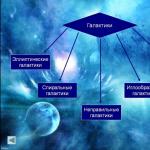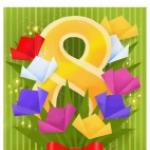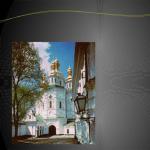Presentation on the topic I love astronomy. Astronomy Presentations
To use presentation previews, create a Google account and log in to it: https://accounts.google.com
Slide captions:
Observations are the basis of astronomy. The presentation was prepared by Pshelenskaya S.V., teacher of physics and astronomy.
Features of astronomy as a science. 1. The main source of information in astronomy is observations. All information about what is happening outside the Earth in outer space can only be obtained on the basis of light and other types of radiation coming from these objects. 2. Almost all phenomena studied in astronomy last long in time (hundreds, millions and billions of years). 3. The need to indicate the position of celestial bodies in space and the impossibility of immediately indicating which of them is closer and which is further from us. All observed luminaries seem equally distant.
A telescope is the main instrument used in astronomy to observe celestial bodies, receive and analyze the radiation coming from them. (tele - far, skopeo - look.) The purpose of the telescope is 1. To collect more light coming from a weak source of radiation. 2. Increase the angle of view from which the celestial object is viewed.
Characteristics of the telescope. Penetrating power - the greater the penetrating power of a telescope, the weaker in luminosity objects it allows to see. The resolution of a telescope is the ability to distinguish small details on the surface of a celestial body.
Both characteristics of a telescope depend on the diameter of its lens. W = F/f – telescope magnification
Telescope - refractor (refracto - refract) - a telescope whose objective is a lens. Galileo's telescope had one converging lens as an objective, and a diverging lens as an eyepiece. This optical design produces a non-inverted (terrestrial) image. The main disadvantages of the Galilean telescope are its very small field of view. This system is still used in theater binoculars, and sometimes in homemade amateur telescopes. Galileo telescope
Kepler's telescope Johannes Kepler improved the telescope in 1611 by replacing the diverging lens in the eyepiece with a converging lens. This made it possible to increase the field of view and pupil relief, but the Kepler system gives an inverted image. Another advantage of the Kepler tube is that it has a real intermediate image in the plane of which a measuring scale can be placed. In fact, all subsequent refracting telescopes are Kepler tubes
Telescope - reflector (reflecto - reflect) - a telescope whose lens is a concave mirror. This telescope design was proposed by Isaac Newton in 1667. Here, a flat diagonal mirror located near the focus deflects a beam of light outside the tube, where the image is viewed through an eyepiece or photographed.
The scheme was proposed by Laurent Cassegrain in 1672. This is a variant of a two-mirror telescope lens. The primary concave mirror of a larger diameter reflects the rays onto a secondary convex mirror of a smaller diameter). The Cassegrain system was modified by the Soviet optician D. D. Maksutov into the Maksutov-Cassegrain system, which became so popular that it is one of the most common systems in astronomy, especially in amateur astronomy.
The largest telescope in Eurasia, the BTA, is located in Russia, in the mountains of the North Caucasus and has a main mirror diameter of 6 m. It has been operating since 1976.
A mirror-lens (meniscus) telescope is a telescope that uses a combination of mirrors and lenses.
Mirror-lens (meniscus) telescope
Radio telescopes are designed to receive cosmic radio radiation.
Thank you for your attention. http:// galactic.name is an astronomical portal where you will find a lot of interesting things for yourself. Materials for the presentation are taken from this site.
Space is an interesting and unknown world. The astronomy presentations collected in this fascinating section will talk about a variety of phenomena in an accessible and very interesting way. The sun, asteroids, great discoveries related to space, biographies of great people who made significant contributions to the knowledge of space, and a lot of other fascinating information that these presentations about space contain will help tell about our universe in an interesting and accessible way. Our presentations are an excellent choice for lessons, lectures, and more.
Presentations on astronomy are made in PowerPoint; here you will find a large assortment of presentations on astronomy that can be downloaded absolutely free. To do this, you need to go to the selected presentation and click on the “download” button. Before this, you can see each slide and view their description. You don’t have to download the files first and only then realize that this is not exactly what you need. If you have difficulty finding the topic you need, you can use the search for all presentations, enter a keyword and we will select the most suitable work for you.
Here you will find presentations on astronomy for both junior and senior students. Thanks to the clarity, colorfulness of the slides, correctly structured and divided into blocks of information, the audience will be able to more easily perceive the subject and better concentrate on the topic.
Abstract to the material
Presentations on astronomy for 11th grade- this is a fairly large section of electronic works that will be of interest to both the teacher and the students to whom they will be shown in class. ICT makes every lesson interesting, despite the fact that the material is not the easiest to learn. However, this does not in any way diminish the enormous role assigned to interactive resources filled with numerous numbers and diagrams, photographs and fragments of fascinating scientific videos, diagrams and strict definitions. All this will make each topic understandable and memorable. Despite the fact that the subject is not an exam, the knowledge acquired by schoolchildren will be useful to many when obtaining higher education. And how nice it is to feel like an expert on the vast Universe, to talk about understandable topics with peers and adults!
Experienced teachers note that download presentations for astronomy lessons in 11th grade It is also necessary in order to present interesting material in an accessible form and diversify training sessions with numerous tasks that will contribute to its memorization and consolidation. You can place electronic crosswords, tests, and test papers on the slides. Every eleventh grader already knows how to use PowerPoint, so why not invite schoolchildren to compose creative works for class themselves. Many such student projects are already in our collection, and every teacher has the opportunity to download them without registration or payment.
Modern teachers can no longer imagine their lessons without electronic aids, without a computer, without high-quality visuals. It’s very easy to have all this on your flash drive and bring it to school not in huge bundles, but in the pocket of your purse, if you are now on this page, since only here you have the chance to download free presentations on all topics for astronomy lessons in the 11th grade. Make your life rich, your activities interesting, and your education high-quality.
Planets of the Solar System – presentation
The presentation talks about all the planets that make up the solar system. The work was completed to a fairly high level. It can be downloaded for free for an astronomy lesson in 11th grade, for demonstration to high school students in electives or in physics classes. The manual examines in detail the terrestrial planets, giant planets and small Pluto, as well as a huge star...
Earth–Moon system – presentation
The presentation, based on the presented material, reveals the topic “Earth-Moon System”. The work can be downloaded for free using the link provided to conduct a physics or astronomy lesson with 11th grade students. Rich illustrative and textual material is presented on 15 slides. By looking at them, schoolchildren will be able to study: information about planet Earth; Moon is a natural...
The physical nature of planets and small bodies of the Solar System - presentation
The presentation provides a general overview of the physical nature of the planets and some small bodies in the Solar System. While studying the topic in an astronomy lesson, students will learn what the diameter of the existing planets is, what the craters on Mercury look like, and what the computer landscape of Venus is like. The remainder of the development presents material on asteroids. Schoolchildren will remember their names, get acquainted with...
Presentation of Terrestrial Planets
The presentation will allow schoolchildren or students studying astronomy (physics) to understand what the terrestrial planets are and how they differ from the extraterrestrial giant planets. The material is quite voluminous, however, studying it in lessons in the 11th grade or in classes at a secondary school will not cause difficulties. Small texts, diagrams, thematic illustrations, diagrams...
Presentation Solar System
A presentation on the topic “Solar System” was compiled for an astronomy lesson. It can be downloaded by those working in 11th grade. The material will also be useful for physics lessons when conducting a corresponding thematic lesson. 17 slides provide information (textual and illustrative) about the terrestrial planets and the giant planets. Students will have to learn their common...
Giant planets - presentation
The presentation is aimed at introducing the 4 major planets of the solar system. These include Jupiter, Saturn, Neptune and Uranus. All of them are united into a special group of bodies because they are significantly different from the Earth and similar planets located near the Sun. Giant planets are characterized by their own “gas” structure. They have a large number of satellites that...
Structure of the Solar System – presentation
The presentation is the necessary demonstration material for physics or astronomy lessons in the 11th grade, where students will study the composition and structure of the Solar system. Students who need to master the topic on their own or repeat it at home can also download the material. The work was completed by the teacher on 17 slides. Its content: the development of astronomy in...
Presentation Meteorites, asteroids, comets, meteors
Four presentations in one archive provide material for introducing meteorites, asteroids, comets and meteors to astronomy lessons. Each manual talks about one of these celestial objects. Both text information and many illustrations are offered for viewing. You can download the archive from the link. It is recommended to use ready-made material in several thematic lessons...
Determining distances for solar system bodies and their sizes - presentation
The presentation gives a clear idea of how distances for solar system bodies and their sizes are determined in practice. Schoolchildren will be able to see this on the basis of the given calculations, which are performed according to certain formulas. To make such calculations, you also need special devices that allow you to correctly determine the distance to an inaccessible object. At the lesson...
Presentation Solar and Lunar Eclipses
The presentation can be downloaded free of charge to accompany an astronomy or physics lesson in which 11th grade students will consider the topic “Solar and Lunar Eclipses.” There is a lot of material in development, it is well systematized. Easy perception will be provided by a large number of diagrams, thematic drawings, and brief definitions that reveal the topic. 25 slides present thematic information: reasons...
Origin of the Solar System – presentation
The presentation introduces 11th grade students to the origin of the solar system and the science of cosmogony, which studies it all. You can download the material for free for astronomy or physics lessons, which focus on the study of this difficult, but quite interesting topic, which provides information about ancient times in combination with modern discoveries of scientists. Before the eyes of the students...
Presentation Artificial Earth satellites
The presentation will tell students how the first artificial satellites of the Earth appeared and what changes have occurred in this area during the time they have been conquering outer space. To consider the topic of an astronomy (or physics) lesson, the teacher will make a short introductory conversation, during which students will repeat their existing knowledge about celestial bodies,...
Starry sky - presentation
A presentation for grade 11 on the topic “Starry Sky” can be shown to students in an astronomy lesson. From it, schoolchildren learn that with the naked eye a person can see up to 3,000 stars in the sky if he is in an open country space with a flat surface. In total, there are about 6...
Presentation Sun
The presentation on the theme “The Sun” is made on 15 colorful slides that will appeal to 11th grade students and will help them study material about the celestial body. Teachers are invited to download the development for an astronomy or physics lesson. Thematic elective classes will also be much more attractive using this resource. Contents of the presentation manual: general characteristics (weight,...
Presentation Ursa Major
The presentation will tell schoolchildren many interesting facts about the constellation Ursa Major. The material is so interesting that both 4th grade students in the outside world and older students in astronomy or physics lessons will enjoy viewing it. Students are offered interesting information about the most famous constellation of 7 stars on 22 slides....
Presentation Structure of the Sun's atmosphere
A presentation for an astronomy lesson on 13 slides presents the topic “Structure of the Sun’s atmosphere.” A strict presentation of the material in laconic blocks, additional illustrations and diagrams will allow you to understand what processes occur far from the Earth and how they affect our lives. The lesson is proposed to be taught on the following topic, using an electronic resource in addition to...
Presentation The movement of the planets of the solar system
The presentation will introduce schoolchildren to the law of universal gravitation and the movement of the planets of the solar system, which is inextricably linked with it. This work can be used in 11th grade when studying the topic in an astronomy lesson. Many natural phenomena obey the universal law of gravity, which was once accidentally discovered by Newton. However, even before...
The presentation is filled with vivid informative material that can be used in an astronomy or physics lesson in grade 11 when studying the topic “Energy sources and the internal structure of the Sun.” Having this electronic resource, it will be easy for a teacher to conduct a training session with high school students at a high level. While demonstrating the slides, the teacher will talk about what different...
Internal structure of the Sun - presentation
The presentation was completed as a project on the subject of astronomy by an 11th grade student. The multimedia manual examines the topic “Internal structure of the Sun.” The content of the 12 slides presented will provide significant assistance to the teacher in conducting an astronomy or physics lesson, as well as elective classes. Each student who shows interest in the discipline can increase their existing understanding of how things work...
Kepler's laws - presentation
The presentation will tell an astronomy lesson in grade 11 about Kepler's laws. During the lesson, it is necessary to understand the essence of these laws, what happens according to them, and how they are used. Brief content of the electronic resource: Kepler's laws refer only to those conditions on the basis of which the movements of all celestial bodies occur. Submits to them...
Presentation Distance to stars
The presentation will be useful to those schoolchildren who are considering determining the distance to stars in an astronomy lesson. This question has been of interest to many for many years, so it is necessary to present the material in such a way that every student can understand how complex calculations can be carried out using formulas. The material is offered on 11 slides: parallax method...
Presentation The Sun and Life on Earth
The presentation reveals the topic of the astronomy lesson “The Sun and the Life of the Earth.” 11th grade students can study the material at home or in class. 8 slides offer thematic text material for study. It tells what the role of the Sun is in maintaining life on planet Earth, in the passage of those processes that we observe. Schoolchildren will receive...
Presentation The influence of the Sun on life on Earth
The presentation contains material about the influence the Sun has on life existing on Earth. The topic is studied in a lesson in 11th grade (physics or astronomy), for which it is recommended to download the manual completed by the student. For a long time, people have been observing the Sun and drawing conclusions about how it can influence those life processes that...
Presentation Structure and evolution of the Universe
The presentation will allow schoolchildren to learn a lot about the structure and evolution of the Universe. You can download the manual for teaching a lesson in 11th grade on the subject of astronomy. You can see the beauty of the Milky Way, learn its history, and get acquainted with the stars of the Galaxy by studying the electronic resource presented on 28 slides, rich in texts and illustrations: Milky Way;...
Astronomy Presentation Templates and Backgrounds
We offer you to download a blank template for an astronomy presentation that can be used by students or teachers to design their own work. The manual contains only 2 slides. However, their number can be increased if you use the “Add Slide” function. The background of the presented slides is unusual. The blue color symbolizes the sky. In the upper right corner you can see the constellation Ursa Major,...
Presentation Ukrainian cosmonauts in space
The presentation introduces schoolchildren to those famous Ukrainian cosmonauts who explored outer space and thereby contributed to space exploration. You can download the material for teaching astronomy lessons in Ukrainian schools or to accompany class hours on the eve of Cosmonautics Day. The development is made on 22 slides. Her texts are written in Ukrainian....
Presentation Double stars
The presentation will introduce schoolchildren to such an unusual, unique natural phenomenon as double stars. Not many people have studied this topic on their own, so the material will be considered with interest in astronomy or physics lessons. The manual is filled with material, which is located on 27 slides. There are enough of them for 11th grade students to figure out what...
Presentation The physical nature of stars
The presentation will help teach 11th grade students about the physical nature of stars. Thematic illustrations and short texts will reveal the topic completely. The astronomy lesson will be interesting and understandable, so we recommend downloading the manual to anyone who wants to add some zest to the lesson and immerse their students in the secrets of the star world, telling about it in a non-boring and...
Presentation Spatial velocities of stars
The presentation is filled with entertaining blocks and thematic information about the spatial velocities of stars; in addition, it contains many additional tasks for organizing independent work by students in an astronomy lesson in the 11th grade. The effectiveness of the lesson will be even greater, since many slides have the additional ability to demonstrate dynamic models. The work is perfect animation that...
Life and intelligence in the Universe - presentation
The presentation tells about the emergence of life and intelligence in the Universe many thousands of years ago. These are very complex processes. They are not only difficult for students to understand, but also difficult to explain to a teacher who will teach an astronomy lesson in 11th grade. This guide will help explain this topic more clearly. 7 slides contain wonderful material...
Planet Neptune – presentation
Teachers and students who will consider this celestial body in an astronomy or physics lesson can download a presentation about the planet Neptune. The work provides interesting information on 6 slides, which will definitely be appreciated by every viewer when studying the topic. The author of the electronic resource is an 8th grade student. In his project he...
Presentation of the Constellation
The presentation will be useful in introducing 11th grade students to the main constellations of the Northern and Southern Hemispheres. In total, the work provides information about 15 celestial objects: Andromeda; Cepheus; The Dragon; Hounds; Perseus; Cassiopeia; Orion; Indian and Bird of Paradise; Eagle; Dolphin; Arrow; Centaurus; Pegasus; Standard Bearer; Sail. A test test is given about each constellation...
Celestial sphere - presentation
The presentation gives an idea of what the celestial sphere and its elements are. The material was selected taking into account the astronomy program for grade 11. The slides contain drawings that explain such complex concepts as declination and right ascension. To check their understanding of the topic, students are given questions that they can answer if they have carefully studied...
Presentation Planet Uranus
A presentation on the topic “Uranus” will tell 11th grade students about that huge planet, which is a huge gas giant. The work describes in detail and illustrates with diagrams what this blue object of celestial space is, located seventh from the Sun. On 15 slides, as if in a blue sky dotted with numerous constellations,...
Zodiac signs – presentation
The presentation introduces children to all 12 signs of the Zodiac. The resource will be interesting and useful not only for an astronomy lesson, but also for independent study. This amazing manual can be studied with interest both by high school students in grades 10-11, and by the most inquisitive elementary or middle school students. At work...
Presentation Our Galaxy
The presentation is an indispensable tool for studying the topic in an astronomy lesson in 11th grade. The work examines our Galaxy, which the author presented not only with informational texts, but also with numerous illustrations. Teachers who teach this discipline in high school (9th - 11th grade) can download the work for free. 23 slides provide material for...
Structure and evolution of the Universe – presentation
A presentation made by Nastya Kirillova on the topic “Structure and Evolution of the Universe” presents thematic material for grade 11. School teachers will use the electronic resource as a visual aid in an astronomy or physics lesson in high school. Students interested in this topic can view the slides in their free time at home by downloading the manual to their computer....
Planet Earth – presentation
This time the presentation for an astronomy lesson in 11th grade will not be devoted to the study of some distant celestial objects. Everything is much simpler and therefore more interesting. Schoolchildren will get acquainted with their native and close planet Earth, and in this lesson there will also be an opportunity to learn about its origin, but for this the teacher...
Presentation Metagalaxy
The presentation will tell about the Metagalaxy, which is still being studied by astronomers and cosmonauts, but remains shrouded in mysteries, which are not so easy to solve due to the distances to those objects that are of great interest. The resource will arouse interest among high school students. His material will be understandable to them. Diagrams and illustrations will allow you to delve deeper into the topic...
What astronomy studies - presentation
The presentation was made to help the teacher who is going to teach a lesson on the topic “What astronomy studies.” The material can be downloaded for an introductory lesson in physics in grades 5-11 or a thematic elective. The story should begin with what kind of science about celestial bodies opens its doors and shares its secrets with...
Presentation Galaxy
The presentation will accompany a lesson in 11th grade on the topic “Galaxy”. Physics (astronomy) teachers working with high school students can download the 11-slide manual for free. Everyone wants to know what the star systems located at a great distance from us are. Schoolchildren will have the opportunity to study the galaxies M82, NGC 6745, NGC 3314, NGC 1410,...
Presentation History of Astronomy
The presentation will allow those who want to study the history of the development of astronomy to look back several centuries. This science is actively developing at the present time, but not many people know that it arose in ancient times, when there were no telescopes and outer space was not explored with the help of modern satellite systems. And how it was, you can...
Celestial coordinates and sphere - presentation
The presentation will introduce students to what the celestial sphere is and how celestial coordinates are determined. The material will be widely used not only in astronomy lessons in the 11th grade, but also in geography or physics. Here, schoolchildren will also get acquainted with star maps. Having opened the first slide, the viewer will immediately be able to find the definition...

To use presentation previews, create a Google account and log in to it: https://accounts.google.com
Slide captions:
ORIGIN OF THE SOLAR SYSTEM - FIRST THOUGHTS AND SCIENTIFIC EXPLANATION
This is our galaxy. Since ancient times, scientists have wanted to know how our solar system came into being.
Friedrich Wilhelm (William) Herschel was born on November 15, 1738 in Hanover (Germany) in the family of a regimental musician of the Hanoverian Guard. Herschel was seriously involved in music theory. From her, his passion moved to mathematics and optics, through which he became acquainted with astronomy.
Using his first homemade reflecting telescope of the Newtonian system, 5.5 feet long (almost 2 m) and a mirror diameter of 20 cm, already in March 1774, Herschel observed a beautiful bright nebula in the constellation Orion
20-foot Herschel telescope. His telescope revealed the nature of the most mysterious objects in the sky at that time - motionless “milky” nebulae
Herschel's 40-foot telescope Observing with a 40-foot telescope, Herschel became convinced that the boundaries of the Galaxy were unreachable. He was also convinced that not all milky nebulae are clumps of diffuse matter and that even the weakest of them, discovered at the limit of visibility, can be other distant “milky ways”.
planetary nebula
The orderly system of planets - their movement in circular orbits lying in the same plane - really beckoned us to study the question of how it came into being
Discharged interstellar gas began to gather in a cloud. The entire solar system, to which the Earth and Moon belong, arose from one large gas and dust cloud
The cloud compressed and its rotation accelerated. Under the influence of increased centrifugal forces, the cloud turned into a disk. The substance became denser and turned into a ring rotating around the center.
This presentation can be used in physics lessons (in the topic "Atoms and Stars", grade 9) and astronomy. I use this material in the elective course “Entertaining Universe” (9th grade). The presentation is a brief excursion into the physical discoveries that underlie modern astronomy. Since research in astronomy began with the invention of the telescope, the presentation describes both the very first - imperfect - telescopes (created by Galileo, later by Newton), and modern reflectors with a large mirror diameter, as well as radio telescopes and their capabilities. Undoubtedly, astronomy received a huge impetus in its development with the invention of photography. The presentation is accompanied by a number of spectacular photographs of our “neighbors” in the Solar System. The most important role in modern astronomy is given to spectral analysis. This is also discussed in the presentation. Naturally, this presentation can only be used in a prepared class (where N. Bohr’s theory and spectra have already been studied). And finally we talk about orbital telescopy - the last word in science. I think this presentation can color the lesson and make it memorable.
Download:
Preview:
To use presentation previews, create a Google account and log in to it: https://accounts.google.com
Slide captions:
Physical research methods in astronomy O.A. Smirnova, Physics teacher MBOU secondary school No. 25 Smolensk
There is nothing so remote from us that we cannot discover. René Descartes 1
Plan Optical telescopes: creation and use Radio astronomy Photographic method Spectral analysis Orbital telescopy 2
Galileo Galilei 1564–1642 Galileo's telescope. Exhibit of the museum in Florence (Italy). 3
Diagram of Galilean telescope 4
Reflector with Newtonian focus 5
Reflector with Cassegrain focus 6
Reflector telescope Five-meter reflector of the Palomar Observatory. The photograph was taken with a long exposure, during which the dome of the tower with an open slit was rotated, which created the effect of its transparency. 7
Radio telescopes Radio telescope in Arecibo, Puerto Rico. VLA radio telescope system in New Mexico (USA). 8
Radar Radar image of the Maxwell Mountains region on Venus, obtained by the Venera-15, -16 spacecraft. Radar image of the lunar crater Tycho. 9
Photographic method Mauna Kea Observatory at night. 10
Surface of the Moon 12
Mercury 13
Mars An image of the surface of Mars obtained by a high-resolution stereo camera from the Mars Express 14 spacecraft
Saturn's moons Tethys Telesto Titan 17 Hyperion
Lunokhod 19
Mars rover Opportunity rover (digital montage) The first photo taken by Opportunity after landing on the surface of Mars 20
Spectra Wavelength Continuous spectrum Sodium spectrum Hydrogen spectrum Helium spectrum 21
Spectral analysis 22
Redshift 23
Schematic diagram of spectrograph 24
Orbital Telescope named after. E. Hubble Photograph of the spiral galaxy M100 before and after correction. 25
Physical research methods in astronomy Optical telescopes Radio astronomy Photographic method Spectral analysis Orbital telescopes 26
The joy of seeing and understanding is the most beautiful gift of nature. Albert Einstein





